General
In 1906 the crew and cadets of T.S. Exmouth took over the site of T.S. Shaftesbury, which had been moored a few hundred yards astern of the Exmouth.
In 1907 the Metropolitan Asylums Board (MAB) purchased the Shaftesbury's Infirmary on West Street from the LCC. The building was cleaned and repainted. The fence around the boundary of the 6-acre playing field was repaired, as was the swimming pool - although MAB considered turning it into a rifle range, as the swimming pool already in use was quite adequate (all cadets had to learn how to swim).
The existing Infirmary in Argent Street moved to its new premises in June 1907. It had 34 beds.
The new Infirmary proved to be a great improvement on the old. Supervision of the boys was easier as all the wards were on the same floor. The health of the boys remained good, apart from occasional cases of ringworm. Medical staff visited the ship at 5.30 a.m. once a month with a view to detect early cases of ophthalmia (conjunctivitis), but none were found in 1907. As well as providing treatment for various ailments,minor operations, such as circumcision for phimosis, were also carried out at the Infirmary.
The extensive playground at the Infirmary enabled the whole ship's company (some 535 boys - there were 65 vacancies) to be accommodated. The boys were landed nearly every afternoon so that the ports of the ship could be opened and the ship thoroughly purified. Thus, any outbreaks of infection would be less serious.
In 1909 there was a scarlet fever outbreak.
By 1910, to fill the vacant places, MAB admitted boys under the age of 13 to the Training Ship. Boys of 11 or 12 years of age had to be at least 4 ft 3 ins (1.3 metres) tall. Boys of known vicious or criminal character were not admitted, as there were reformatory or industrial ships for those types.
In 1910 a steam disinfector was built in the grounds to deal with the clothes and bedding used on board by those suffering from infectious diseases. During that year three cases of scarlet fever were transferred to the Eastern Fever Hospital, while one boy with acute mastoid disease was sent to St Bartholomew's Hospital.
In 1914 the Infirmary treated cases of scarlet fever and diphtheria. The more seriously affected patients with infectious diseases were sent to other hospitals - Queen Mary's Hospital, the Eastern Fever Hospital or White Oak (for ophthalmia).
In 1930 MAB was abolished and the LCC took over control of the Training Ship.
Following an outbreak of ringworm in 1934, the affected boys were transferred to the Hanwell Schools (which had closed the previous year) for treatment.
At the outbreak of WW2 the cadets and crew were evacuated to Burnham on Crouch and the Exmouth was requisitioned by the Admiralty for use as a depot ship.
Present status (January 2009)
The area has been completely redeveloped and nothing remains of the Infirmary or of the Health Centre that supposedly replaced it. The site is now occupied by Vicarage Square.
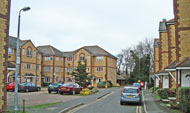
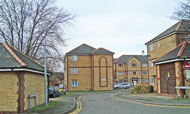
Vicarage Square.
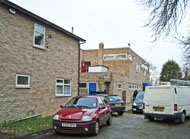
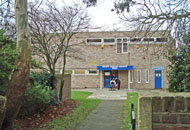
Looking from Vicarage Square (left) towards the Grays Parish Church Hall (right).
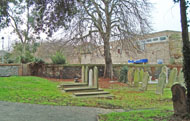
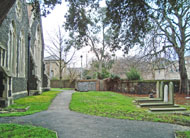
Looking across the graveyard towards the Church Hall (left) and across the graveyard past the church.
The Shaftesbury was an Industrial School Training Ship for unmanageable boys which opened in 1877 under the administration of the School Board for London. She housed a maximum of 425 boys (but, in July 1899, the number was limited to 400 by the Home Office).
The ship had been built in 1854 as the Nubia, and had an iron hull, one funnel and three masts rigged for sail. She had originally been owned by the Peninsular and Oriental Co., who used her for the Southampton to Alexandria service.
In December 1877 she was sold to the School Board for London and converted into a Training Ship. She was renamed the Shaftesbury.
The boys, whose chief crimes were begging late at night or stealing, had all been referred by magistrates who had the choice of sending them - for a determined period - to an industrial school, a truant school or a training ship. If the latter, a policeman or one of the Board's inspectors would accompany the child by train and hand him over to the Petty Officer. The boy would then be bathed thoroughly by two of the older cadets and, before being dressed in his new Jack-tar uniform, his hair was cut. He was then allowed to join the other boys.
The boys slept in hammocks slung from iron bars in the ceiling on all the decks, so they had plenty of space and air. The hammocks were folded away in bags during the day.
Half their day was devoted to normal school lessons and the rest to learning seamanship, carpentry and other useful occupations. They also learned to play musical instruments.
It was found that 98% of those drafted into the army and navy and 85% of those who went into general employment turned out well, despite the stigma of being a 'criminal'.
The Shaftesbury closed in April 1905 and was sold for scrap in 1906.
(Author unstated) 1903 The"Shaftesbury" Training Ship. British Medical Journal 2 (2237), 1301-1302.
http://gallery.nen.gov.uk
http://hansard.millbanksystems.com
www.british-history.ac.uk
www.bygonegraysthurrock.co.uk
www.cityoflondon.gov.uk
www.hms-worcester.me.uk (1)
www.hms-worcester.me.uk (2)
www.rakaia.co.uk
www.theshipslist.com
www.thurrock.gov.uk
www.thurrock-community.org.uk
Return to home page